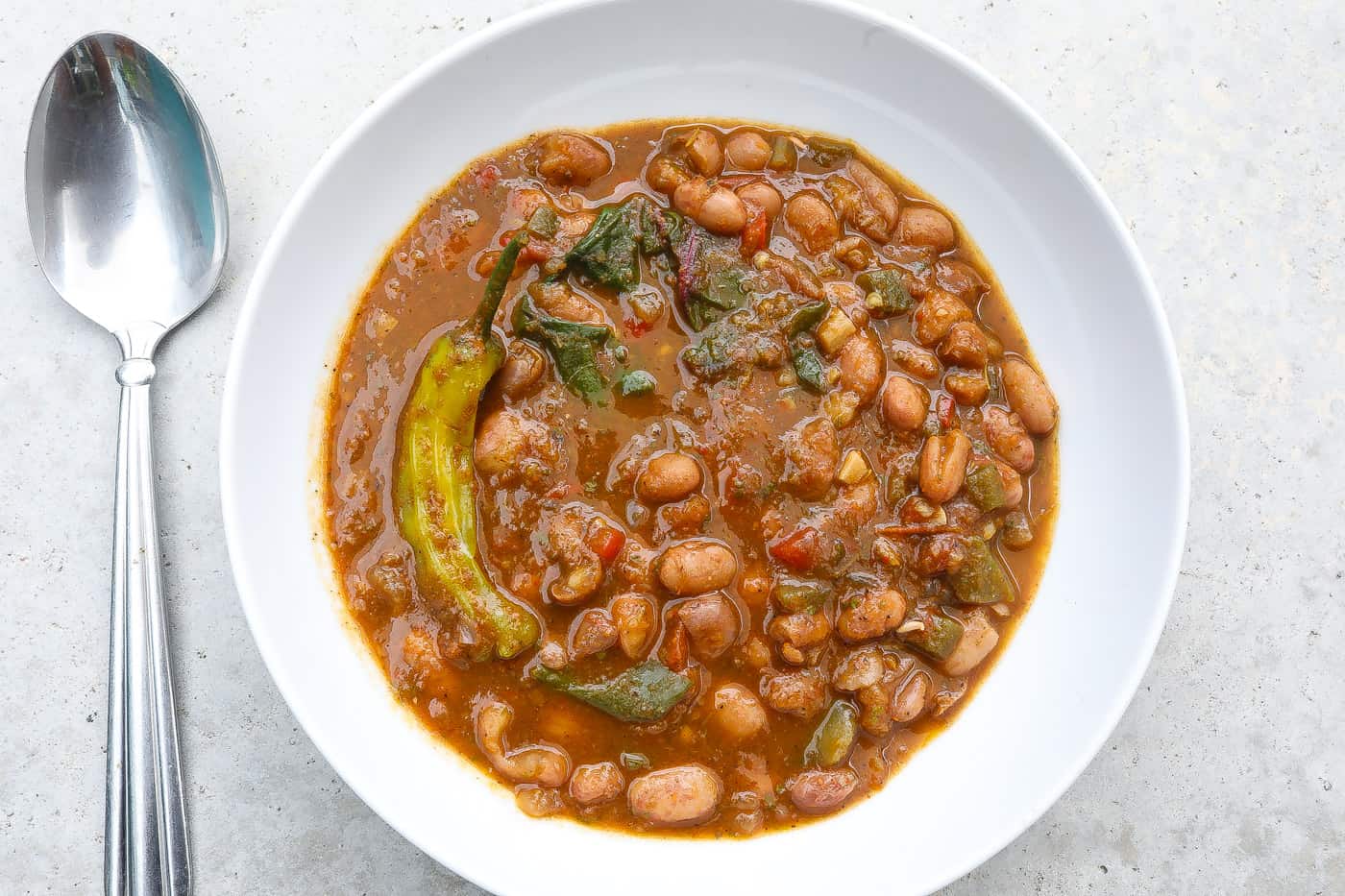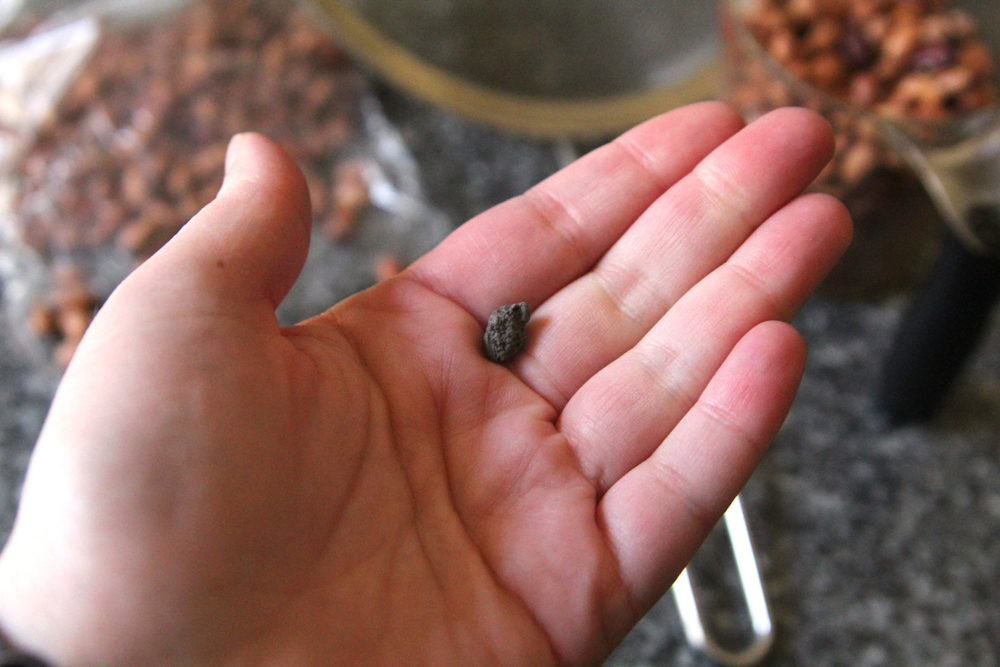Dried cranberry beans have little red spots, giving them their name. If you have dried cranberry beans that you want to cook so that you can use them in recipes, this guide will help you do that.
Sometime around a year ago, my son Will came across a cranberry bean burger recipe that he chose to try. I bought the beans, but we never got to the recipe. Eventually, I forgot which cookbook it was in.
But I should do something with the dried cranberry beans since I found them while cleaning out the pantry. Since I’ve been staying home and cooking all the meals, I’m getting used to being able to play, try new things, and get out of my kitchen routines.
Cranberry beans have a slightly nutty flavor to them. They are creamy in texture — velvety, even, and not mealy. We’ve enjoyed them in skillet dishes and in bean burgers as well.
I’ve also bought boxed beans before; they’re like canned beans but without the can. But in the US, these are usually sold dried. Or, at least in my area of the US.
Cranberry beans, also known as borlotti beans are a beautiful speckled heirloom variety of beans that can add vibrant color and delicious flavor to many dishes. While dried cranberry beans require some advance preparation they are worth the extra effort. When cooked properly, these creamy, nutty beans have a tender texture and sweet, earthy flavor that stands out in soups, stews, salads, and more.
If you’re new to cooking with dried beans, preparing cranberry beans can seem daunting. But have no fear! With this simple step-by-step guide, you’ll learn everything you need to know to prepare perfect cranberry beans at home
Ingredients
- 1 pound (about 2 cups) dried cranberry beans
- 10 cups water
- 1 teaspoon salt
- 1 bay leaf (optional)
- 2 tablespoons olive oil or butter (optional)
Equipment
- Large bowl or pot for soaking beans
- Colander
- Large pot with lid for cooking beans
Step 1 – Sort and Rinse the Beans
The first step when preparing any dried bean is to sort through them to remove any debris like small stones or shriveled beans. Put the beans in a large bowl or pot and pick out anything that doesn’t look like a bean. Then, rinse the beans thoroughly in a colander under cool running water. This cleans the beans and washes away any dust or residue.
Step 2 – Soak the Beans
Soaking is an important step that helps soften the beans and reduces cooking time. After rinsing, place the beans back in the large bowl or pot and cover with at least 2 inches of cool water. Let soak at room temperature for 8 hours or up to overnight. The beans will expand to about double their dried size as they soak and begin to soften.
Step 3 – Drain and Rinse Soaked Beans
Once the beans have soaked, drain them in a colander and rinse under cool running water. This rinses away the water they soaked in which can cause beans to toughen while cooking if not rinsed off.
Step 4 – Add Beans and Fresh Water to a Pot
Put the soaked, rinsed beans in a large pot and add 10 cups of fresh water. The extra water is key during cooking to keep the beans hydrated.
Step 5 – Bring Beans to a Boil
Place the pot with the beans and water over high heat. Bring to a rolling boil.
Step 6 – Skim off Foam
Once boiling, foam will rise to the top. Use a large spoon to skim off and discard this foam. Removing it helps keep the cooking liquid clear.
Step 7 – Add Salt and Bay Leaf
After skimming, add 1 teaspoon salt and a bay leaf if desired. The salt adds flavor and helps beans cook evenly. The bay leaf adds a subtle herbal note.
Step 8 – Reduce Heat and Simmer
Once boiling, reduce heat to low and let the beans simmer gently with the lid tilted for even evaporation. Simmering beans shouldn’t boil rapidly but should have bubbles periodically breaking the surface.
Step 9 – Cook Until Tender
Cooking time can vary depending on the age of the beans, usually 1 1⁄4 to 2 hours. Check after 1 hour.Beans are done when very tender all the way through. Taste a bean to check – it should be soft and creamy, not crunchy.
Step 10 – Season and Finish with Olive Oil or Butter
When beans are tender, turn off heat. Taste and add more salt if desired. For added richness, swirl in 1-2 tablespoons olive oil or butter. The fat adds flavor and gives beans a silky texture.
And that’s it! With these simple steps, you can enjoy perfect cranberry beans. The cooked beans can be used in any recipe calling for pre-cooked beans. Leftovers will keep refrigerated for 4-5 days or frozen for 4-6 months.
Some serving ideas for your home-cooked cranberry beans:
- Bean salads or grain bowls – Toss beans with veggies, greens, and a vinaigrette
- Soups and chilis – Add beans for protein and texture
- Sides – Serve beans warm or chilled as a side dish
- Bean dips and spreads – Purée beans into dips like hummus or crostini spreads
- Vegetarian mains – Build bowls or tacos around beans for a hearty plant-based meal
With their robust flavor and striking color, cranberry beans are worth seeking out and preparing yourself. Once you master the easy process, you’ll never go back to canned beans again. Homemade cranberry beans are infinitely tastier and more economical. Add them to your pantry staples and enjoy their delicious versatility all year long.

How do you cook cranberry beans?

You cook dried cranberry beans first by boiling them. This can be done on the stove, but I prefer using my slow cooker.
Before you do that though, you need to rinse and pick the beans over. Sometimes little stones get mixed in and you want to pick them out before cooking.
And yes, I have actually found little stones before (including while cooking cranberry beans). The good news is that they are easy to spot.
Once the cranberry beans are soft, they can be used in a variety of recipes such as Cranberry Bean Salad with Basil, Mint and Feta and Cranberry Bean Gartin. Stewed Cranberry Beans with Kale sounds delightful. And I can vouch for their deliciousness in a bean burger.
What are cranberry beans?
Originally grown in Colombia but also popular in Italy (thanks to Fine Cooking for those facts), cranberry beans are smooth, oval-shaped beans. Sometimes whiter in color, sometimes tanner, they are noted for the pink to maroon spots all over them.
According to the venerable James Beard Foundation, cranberry beans — also called borlotti beans —are available fresh in the late summer and fall (I should note that I haven’t seen them myself, but they must be available somewhere).
BEANS RECIPE | CRANBERRY BEANS | HOW TO COOK BEANS
FAQ
Do cranberry beans need to be shelled?
Can you eat fresh cranberry beans raw?
How to know when cranberry beans are ready?
What are cranberry beans good for?
How to cook cranberry beans?
If you ever wondered how to cook cranberry beans and what to do with them, this recipe is perfect for you. It is quick, simple and super flavorful. Heat the olive oil in a deep skillet over medium heat. Add the garlic and tilt the pan so all the oil goes to one side of the pan and the garlic cooks evenly.
What is the difference between cranberries and cranberry beans?
Cranberries and cranberry beans are two very different things. Cranberry beans are a type of food that is related to kidney beans. They come from the same family.
Can you cook cranberry beans overnight?
If you can only find dry cranberry beans, you will need to soak them overnight in 2.5 times their volume in water. Add a couple of teaspoons of baking soda. The next day, rinse the cranberry beans really well and follow the cooking instructions.
Can you eat canned cranberry beans?
Eating more fiber can mean eating more beans for many, so it’s nice to embrace canned beans. But it’s also nice to take the time and care to perfect cooking dried beans. To help our cranberry beans cook up creamy and tender, we soak them overnight in salt water before thoroughly rinsing them to remove any excess salt.
